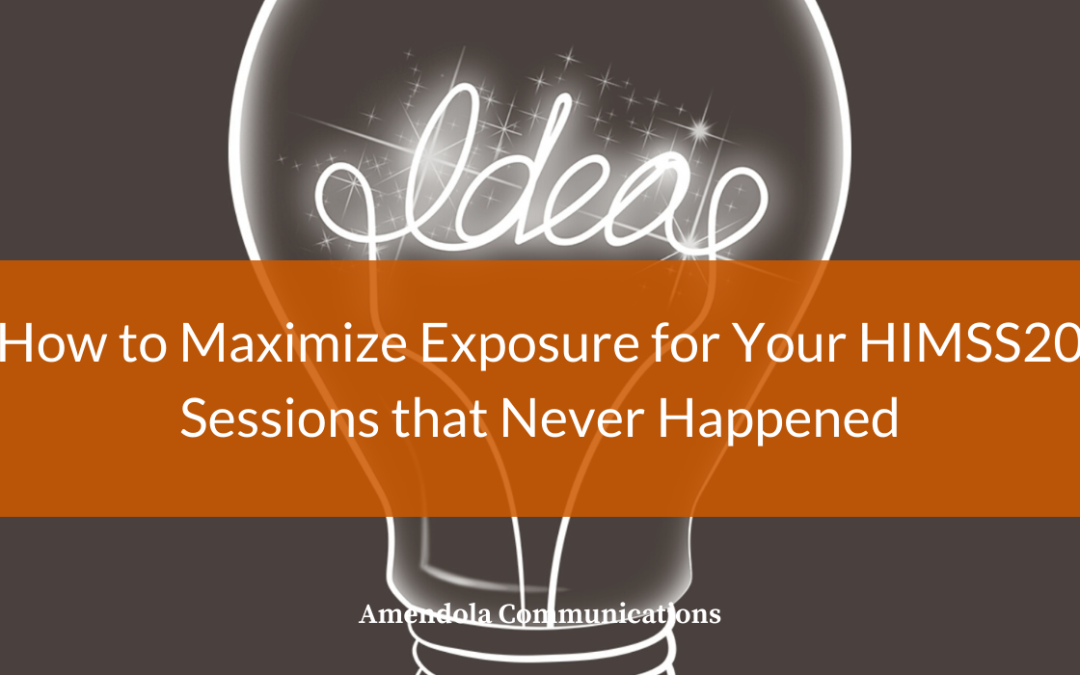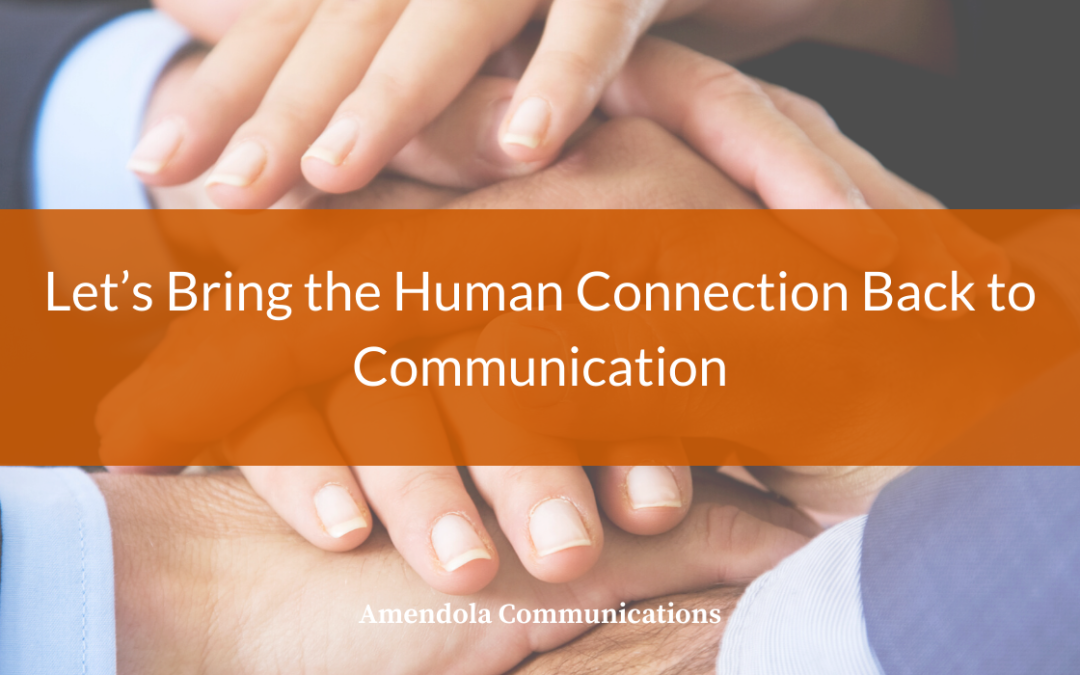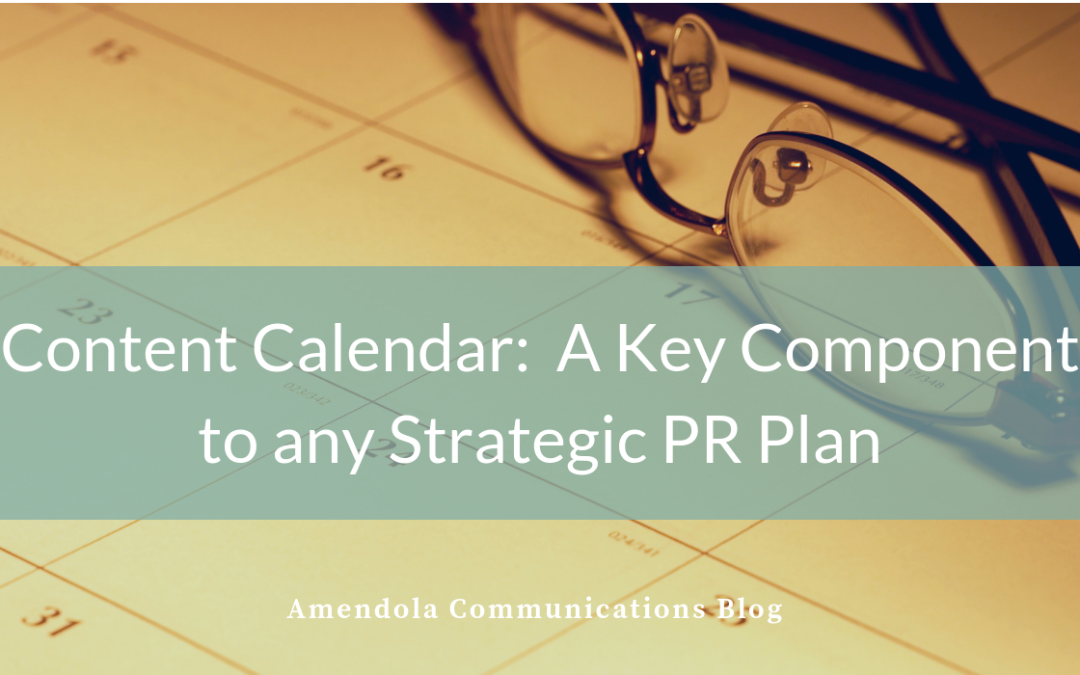
by Linda Healan | Apr 1, 2020 | Blog
In the wake of HIMSS20 being cancelled, many people whose HIMSS presentations were accepted for this year’s conference are lamenting the fact that the sessions that they worked so hard to get accepted won’t be given.
Let’s face it, there is a ton of work that goes into submitting presentations for HIMSS, including the process of preparing those lengthy and detailed applications.
As a colleague described in a previous blog, “the process is not easy and takes anywhere from 12-16 hours per proposal” and “HIMSS has a less than 30%
acceptance rate.”
So, you might be asking, what do we do now? For many it feels like that opportunity is lost, but it doesn’t have to be. Here are some different ways to take the content you were going to present and still get it out there.
- Take advantage of HIMSS’ virtual conference.
- Plan your own virtual conference: You can conduct a webinar with the information you were going to present at HIMSS, with both a live virtual presentation and on-demand access after the fact.
- Use information from your HIMSS presentation to draft thought leadership articles and case studies. There are likely a ton of facts and statistics that were a part of the presentation that could be included.
- Look at other conferences for speaking opportunities later in the year or in 2021 that you can submit these completed presentations to knowing that some of the stats may need to be updated and the submissions will need to be customized for each opportunity.
The cancellation of HIMSS20 doesn’t mean that all the hard work that you put into your presentations must go to waste. The show can still go on, just a bit
differently.

by Linda Healan | Jan 15, 2020 | Blog
We’ve all seen articles in the press about overuse of social media and technology by our kids and teens. It’s absolutely pervasive in school, during classes, and in many homes.
I’ve had numerous conversations with my high school sophomore about her generation’s overuse of technology as a communications tool and how it’s leading to shortfalls in interpersonal skills. These kids don’t really know how to interact with each other without their phones. In fact, they don’t even use their phones for actual phone calls. I could go on, but I won’t. If you have a teenager, I bet you can relate.
Technology can be a great thing for business. We use email universally and texts are even becoming more common. But perhaps like our kids we are overusing it a bit. Maybe we should take a step back and remember the importance of “conversations” either over the phone or ideally face-to-face.
Back in the day in high tech PR, we used to conduct press tours and analyst tours so our clients could have face-to-face meetings with key influencers. It was a great opportunity to educate them about new products or services. And more importantly, it was an opportunity to build or cultivate key relationships.
Through the use of technology, press tours are no longer needed not that the media have a ton of bandwidth for meetings these days. Nor are they concentrated in a few media hubs like they used to be.
We have learned to rely on email pitches, phone interviews and if it’s really something special, maybe a video conference call so we can screenshare and provide a product demo. Again, a great use of technology that saves time and travel budgets, but what about the relationship building?
In healthcare IT, we have conferences and tradeshows such as HIMSS, HLTH, AHIMA, and so on, where we try to schedule a few minutes with very busy journalists and analysts to get some “face time” for our clients and their customers. But these are rushed meetings where we hope to communicate the news ““ fingers crossed that the editor or analyst retains what we talked about along with their 20 other meetings that day. They don’t call it #HIMSSanity for nothing.
We are in public relations, but do we take time to actually build and nurture the relationships anymore?
I’m lucky that I have a local client here in Atlanta who I get to have face-to-face meetings with occasionally. We could certainly conduct our check-ins over the phone and quite often we do. However, when I get the chance to go meet with them and brainstorm in person, plan strategy, discuss new ways of talking about their solutions, and even talk about the weather and learn about their families, it builds bonds. And quite often we end our meetings with hugs not handshakes maybe that’s a Southern thing.
This is a topic that I have been thinking about a lot lately and I’ve tried to incorporate it into my daily work. When I’m planning to send a colleague a complicated, wordy email that would be better discussed live, I choose to pick-up the phone and have a conversation instead. There is no lost nuance that can often result in an email or text communication, and I leave the conversation knowing my colleague a little bit better. And we begin to develop a bond. And hopefully that bond, that communication, delivers a better outcome for our clients.
As entrepreneur Paul J. Meyer said, “Communication – the human connection – is the key to personal and career success.”
How can you spend more meaningful time communicating and building business relationships? Let’s not be like our kids.
by Linda Healan | Sep 4, 2019 | Blog
It’s September. The kids are back to school and summer vacations are over. It’s the time of the year when our clients start planning their PR budgets for 2020. What are some considerations for you to make when planning your company’s public relations budget? Here’s a list of a few to consider:
- Know your goals. Public Relations goals can be as few or as many as you need. Just be sure to be consistent with your business and marketing goals. Examples of these goals include increasing traffic to your website, increasing your share of voice, highlighting key customer accomplishments or introducing and utilizing new subject matter experts from your company. Whatever your goals are, make sure they are SMART specific, measurable, attainable, realistic and timely.
- Events Major events or trade shows such as HIMSS take a tremendous amount of planning and preparation to be a success. It’s important to budget for the additional work necessary to lead up to major conferences and in many cases that work can start four months in advance. Have you considered any special events your company would like to host at the tradeshow? Are you planning for press and analyst meetings and support from your PR team at the events? Have your marketing materials and key messages been updated to support any announcements you plan to make at the show? Don’t forget to include travel expenses as part of your budget.
- New Product Announcements Most technology companies have a schedule of when they can announce new products or product enhancements. New product announcements can sometimes be a heavier lift for your PR team. Planning in advance for any necessary analyst briefings is a great strategy. Have you considered a paid relationship with a key analyst as part to of your marketing or PR budget? What about a webinar to help promote your new product? There can be website and messaging enhancements needed around a new product announcement as well.
- Customer promotion Getting customers to agree to interviews or case studies is what the media desperately wants. But it doesn’t happen with a snap of the fingers. Having internal support to foster client relationships and educate them on the value of promoting their relationship with your company is key. And there is time involved in developing that customer story interviews, writing, editing, approvals and pitching those stories. It can take a lot of work. If you have customers that are willing to speak about their experience utilizing your technology, you need to have a strategy and budget in place to support this gold mine opportunity.
- Team Expertise When you begin working on your marketing/PR budget for 2020, it helps to have an industry-knowledgeable outside resource to bounce ideas off of. Your Amendola team can help you build an annual plan to help you achieve your public relations goals. As your PR partners, your team will have a great feel for what worked previously and what might be good opportunities to change things up to achieve great results in the coming year. Once you have a solid PR plan in place, it will be much easier to build out the PR section of your marketing budget.
Next January may seem like it’s a long way away, but in marketing-time it’s really not. Be sure you start planning now so you’re ready to hit the ground running in 2020.
by Linda Healan | Jan 30, 2019 | Blog
HIMSS19 is fast approaching and for a successful conference, you are likely already planning and preparing. The Amendola team is in full swing preparing clients for the big show in Orlando, from product announcements, media kit development and booth collateral to social media campaigns and on-site support for press interviews and analyst briefings.
We’ve written a number of blogs on the subject of HIMSS including Getting Noticed at HIMSS: 4 Insider Tips from Industry Journalists to Maximize Media & Analyst Interviews at HIMSS and also Tips for Staying Healthy at HIMSS. There is some valuable information here from my A-Team colleagues. I’d like to highlight the information I find most valuable and add a few tidbits of my own wisdom to the topic.
First a few facts. The 2019 HIMSS Conference in Orlando will be bringing together 45,000+ professionals from 90+ countries. There will be 300+ education sessions, 1,300+ vendors, hundreds of special programs and endless networking events. The conference will be held at the Orange County Convention Center which boasts 7 million square feet of meeting and exhibition space.
Yes, that’s a lot of people and a lot of walking. In addition to hand sanitizer, a supply of ibuprofen, tums, breath mints and good shoes, I also recommend the following:
- Have a fresh supply of water and snacks with you each day. With the amount of people in attendance, getting a quick meal during a break in meetings or sessions may not always be an option.
- You will be doing a lot of walking. I think one HIMSS I walked over 10 miles in one day. Track your steps. You will be getting your exercise. All that walking will be tough on your feet, but also on your legs, hips and possibly your lower back. Perform leg and lower back stretches in the morning, at night before you go to bed, and even throughout the day if you can manage it.
- The weather in Orlando in February is gorgeous, especially for those of us who have been dealing with a cold and wet winter. Take a few minutes to get outside the convention center and enjoy the fresh air and sunshine. Sometimes that can be a better “pick-me-up” than another cup of coffee.
- Do your homework prior to the show. Read the briefing book, including article links, your PR agency provides you to prepare for your press and analyst meetings. It’s an excellent way to spend time on your flight to Orlando.
- Know your elevator pitch and the key messages you want to convey during the show. Be prepared to convey those messages on the fly with someone you chat with while waiting in line for coffee. You never know who may be standing around you a journalist, an analyst, a potential customer always represent your company well.
- Finally, have fun! HIMSS is hectic and tiring, but also exciting and can set the stage for a year of success. And when it’s over, enjoy some extra time in Orlando. You are close to the most magical place in the world as well as beautiful beaches less than an hour away. And if you are like me, be sure to make a reservation for a massage after HIMSS is over. Your body will thank you for it!
See you in Orlando!

by Linda Healan | Oct 31, 2018 | Blog
Oftentimes public relations professionals think of content calendars as a tool for marketing communications programs. Having an internal editorial calendar is absolutely important for any content program. Since an integrated public relations campaign has evolved from just media relations, PR pros should also consider a content calendar as part of their overall strategic PR plan.
Knowing your audience(s) is one of the primary tenants of public relations, and the purpose of any good content is to engage, educate and encourage action. Therefore, it is necessary for us to identify those people who really are influential and approach them through high-quality content rather than corporate or product blurbs.
It is also essential to make sure that a content calendar is developed based on your overall marketing goals. What do you want to accomplish this year? What new products will be announced? Are you a start-up just entering the market or are you positioning for an IPO, other investments or hoping for an exit strategy? Positioning your executives as subject matter experts and/or thought leaders is always a good strategy in any PR Plan.
So, what should be incorporated into a public relations content calendar to reach appropriate audiences and support marketing objectives?
Events
Events are one of the best opportunities to make your public relations strategy successful, whether it is through external trade shows such as HIMSS or other health/medical conferences or internal events such as webinars and user groups. Listing upcoming events in your content calendar allows you to develop content that strategically targets potential buyers as well as current customers, and position executives and thought leaders, all based on the timeline for the events. You can tie press releases and customer case studies to events, announce executive speakers or even blog about your giveaways at a trade show.
Press Releases
A well accepted strategy in PR is to average one press release every month. This allows you to keep your name and messaging top of mind and fresh with reporters. Scheduling your press releases in advance of industry events and around product launches helps your PR team coordinate with your marketing team to make sure the news is ready to be disseminated at the right time.
Articles/Case Studies
Thought leadership articles and case studies are excellent tools in the arsenal of any PR professional to demonstrate your knowledge and experience. Planning to develop these types of articles in your content calendar and then pitching for placement in key media outlets is the kind of valuable coverage many organizations desire. Compare the articles you plan to develop to the next category editorial opportunity calendars and you’ve got a head start on content that can be published.
Editorial Opportunity Calendars
Years ago, editorial opportunity calendars were the bread and butter in any PR campaign. With the move towards online media, many publications no longer publish or adhere to editorial calendars. But some still do and researching those calendars and adding key opportunities to your PR content calendar allows you to develop content in a timely basis to pitch to those media outlets. Make sure, however, that you build in lead times into your calendar. Another benefit to editorial calendars is they give you an idea of what topics the media is interested in covering and can help you develop a list of content ideas for the year.
Other categories that can be included in an integrated PR content calendar are blogs, customer newsletters and social media outreach. There are plenty of free tools on the web that you can use to develop a content calendar.
In the end, it all works together. Having a calendar of events, press releases and editorial opportunities allows a public relations professional to strategically plan to develop content that meets deadlines, achieves marketing goals and engages, educates and encourages action from your key audiences.


